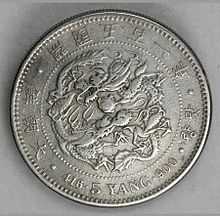Korean yang
| Yang | |
| Hangul | 양 |
|---|---|
| Hanja | 兩 |
| Revised Romanization | yang |
| McCune–Reischauer | yang |
| Fun | |
| Hangul | 분 or 푼 |
|---|---|
| Hanja | 分 |
| Revised Romanization | bun or pun |
| McCune–Reischauer | pun or p'un |
The yang (양/兩) was the currency of Korea between 1892 and 1902. It was subdivided into 10 jeon (전/錢), 100 bun (분/分) and 5 yang = 1 hwan (환/圜).
Etymology
The word yang is a cognate of the Chinese "tael" (pronounced "liǎng" in Chinese). Fun (pronounced "pun" but spelt with an "f" on the coins), is also a cognate of a Chinese word, fen, which is equal to 1/100 yuan, whilst hwan is a cognate of yuan itself.
History
Just before the yang was introduced, a small number of coins denominated in hwan (환/圜) and mun (문/文) were minted (1 won = 1000 mun). It is unclear whether these coins circulated. The 1 won and 5 yang coins were equal in size, containing 416 grains of silver. However, before 1892, the main currency of Korea was the mun, a denomination based on the Chinese cash (Chinese: 文 wén).
The mintage and circulation of modern currency began during the last years of the old Korean Empire as a result of contact with the West. Around the time of the trial adoption of the gold standard in 1901, gold and silver coins were in circulation along with some Japanese bank notes.
The yang was replaced by the won at a rate of 1 won = 5 yang.
Coins
Coins were minted in the denominations of 1 fun, 5 fun, ¼ yang, 1 yang, 5 yang and 1 hwan. The coins all carried the title of the state, "Great Joseon" (Great Korea; 대조선; 大朝鮮), then just "Joseon" (Korea; 조선; 朝鮮) and then Daehan (대한; 大韓). Until 1897, the dynastic dating system was used, where the founding year of the Joseon Dynasty, 1392, was year 1. Starting in 1897, the regnal year of the monarch was used instead.

| Denomination | Composition |
|---|---|
| 1 pun | Brass |
| 5 pun | Copper |
| ¼ yang | Initially cupronickel and then copper around silver |
| 1 yang | 800‰ silver |
| 5 yang | 900‰ silver |
| 1 hwan (=5 yang) |
Banknotes
A series was printed by the Treasury Department but never issued. The denominations were 5 yang, 10 yang, 20 yang, and 50 yang.
References
- Schuler, Kurt. "Tables of Modern Monetary History: Asia".
- Krause, Chester L., and Clifford Mishler (2004). Standard Catalog of World Coins: 1801–1900. Colin R. Bruce II (senior editor) (4th ed.). Krause Publications. ISBN 0873497988.
- Pick, Albert (1996). Standard Catalog of World Paper Money: General Issues to 1960. Colin R. Bruce II and Neil Shafer (editors) (8th ed.). Krause Publications. ISBN 0-87341-469-1.
| Preceded by: Korean mun and Chinese currencies to some extent Reason: currency reform |
Currency of Korea 1892 – 1902 |
Succeeded by: Korean won and Korean yen Reason: heavier influence by Japan Ratio: 1 yen = 1 won = 5 yang |
| |||||||||||||||||||||||